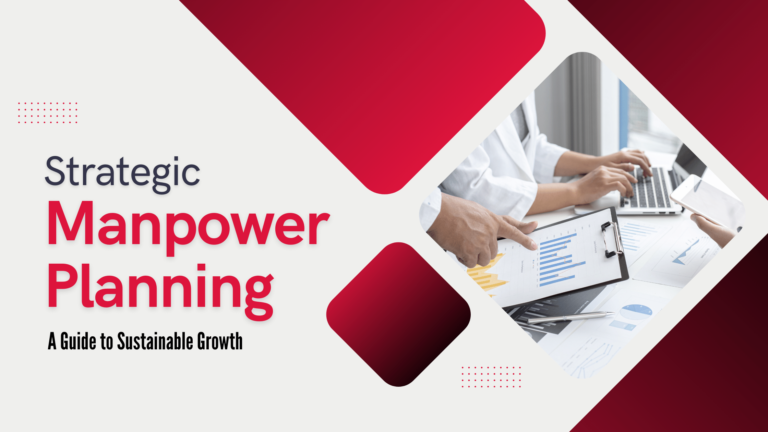
In the dynamic and ever-evolving business landscape, organizations are constantly challenged to adapt to changes and ensure sustainable growth. One of the crucial elements in achieving this growth is Strategic Manpower Planning. This strategic approach to managing human resources goes beyond traditional hiring processes, focusing on aligning workforce capabilities with organizational goals. In this blog, we will explore the significance of Strategic Manpower Planning and provide a comprehensive guide to help organizations navigate this critical aspect of sustainable growth.
Understanding Strategic Manpower Planning
Strategic Manpower Planning involves the systematic identification and development of the human resources required to meet organizational objectives. It goes beyond the short-term hiring needs and looks at the long-term goals of the company. This approach considers the organization’s current workforce, anticipates future requirements and aligns talent management strategies with overall business strategies.
Key Components of Strategic Manpower Planning
> Environmental Analysis
Before diving into manpower planning, organizations must conduct a thorough analysis of the external environment. This includes economic trends, technological advancements, and industry-specific factors that may impact the workforce. Understanding these external factors enables organizations to make informed decisions about their talent needs.
> Internal Workforce Assessment
Evaluate the current workforce’s skills, capabilities, and potential for growth. Identify key positions and skills critical to achieving organizational objectives. Assessing the internal talent pool helps in recognizing gaps and areas that require development.
> Forecasting Future Requirements
Project the future workforce needs based on business goals, expansion plans, and anticipated changes in the industry. Consider factors such as retirements, attrition rates, and advancements in technology that may impact the demand for certain skills.
> Skill Gap Analysis
Analyze the existing skills within the organization against the skills required for future success. Identify areas where the organization may face a shortage of talent and develop strategies to bridge these skill gaps through training, recruitment, or talent development programs.
> Talent Acquisition Strategies
Develop effective strategies for acquiring talent, including recruitment, onboarding, and talent retention. Consider both internal and external sources for talent acquisition. Leverage technology to streamline the recruitment process and attract top talent.
> Succession Planning
Identify and groom potential leaders within the organization. Succession planning ensures a smooth transition of leadership roles, minimizing disruptions during key personnel changes.
> Continuous Monitoring and Evaluation
Manpower planning is an ongoing process that requires regular monitoring and evaluation. Periodically reassess the workforce against organizational goals and adjust strategies as needed. This ensures that the organization remains agile and responsive to changing circumstances.
Benefits of Strategic Manpower Planning
> Improved Decision-Making
Strategic Manpower Planning enables organizations to make informed decisions regarding talent acquisition, development, and deployment, aligning workforce capabilities with business goals.
> Cost Efficiency
By identifying and addressing skill gaps proactively, organizations can avoid unnecessary recruitment costs and reduce turnover expenses. Strategic Manpower Planning helps optimize the utilization of existing resources. organization.
> Enhanced Employee Engagement
Employees who see a clear path for growth within the organization are more engaged and motivated. Strategic Manpower Planning fosters a positive work environment and encourages continuous learning and development.
> Increased Agility
Organizations that regularly assess and adjust their workforce strategies are better equipped to adapt to changes in the business environment. This increased agility is crucial for sustainable growth.
Conclusion
Manpower Planning is not just a reactive response tooal immediate hiring needs; it is a proactive and forward-thinking approach to human resource management. By aligning workforce capabilities with long-term organizational goals, businesses can ensure sustainable growth and navigate the complexities of the modern business landscape with confidence. Embracing Strategic Manpower Planning is an investment in the future success of the organization, fostering a resilient and adaptable workforce ready to tackle challenges and capitalize on opportunities.
Discover tailored manpower solutions with TCM Solutions. Let us align your talent strategy with your business needs. Elevate your success – Contact us today for your manpower planning that works for you!


Your method of describing everything in this piece of writing iss genuinely good,
all can effortllessly bee aware of it,Thanks a lot.